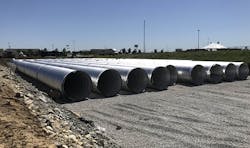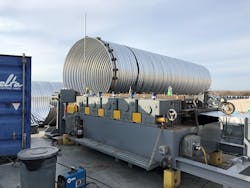Centrally located in the United States, the BNSF Alliance Intermodal Facility is one of the world's premier inland ports and offers strategic multi-modal transportation access between the BNSF Railway, the Fort Worth Alliance Airport (the world's first 100% industrial airport), Interstate Highway 35W from Mexico to Canada, and Amazon, FedEx and UPS ground hubs. Fueled by the increase in online commerce, the facility has been the center of a multi-year expansion project involving more than 1,200-acres of development.
Contech has been actively involved with the facility's expansion throughout the years, having first provided erosion control and drainage solutions when the site was first expanded in 2007. More recently, Contech has provided A-2000 PVC pipe and slotted drain for stormwater conveyance and geogrid reinforcement for the pavement sections.
The 2019 scope of work included increasing the capacity at the terminal by constructing new parking stalls for 1,300 intermodal containers. The storage requirements were massive, requiring over 680,000 cubic feet of storage. The site did not allow for conventional above-ground storage, so using the Construction Manager/General Contractor (CMGC) Delivery Method, the team from BNSF and Ames Construction conducted a cost and constructability comparison cost of several material options, including HDPE chambers/pipe and concrete solutions. Corrugated metal pipe (CMP) was determined to be the optimal due to its low total installed cost and expediency of lead times.
To accommodate the accelerated timeline, Contech worked with Ames and BNSF through the fall of 2019 to design a detention system made from 16,023 feet of aluminized corrugated metal pipe (CMP). Varying diameter pipes (96", 84", 72", and 60") were utilized to meet grading constraints. Additionally, the system was designed as two separate sub-basins to avoid existing utilities and wetland areas. Two lateral manifold pipes hydraulically connected the two systems.
Designing a system from 60%-90% plans, manufacturing 16,000 feet of CMP, and delivering onsite within 3-4 months was no easy task, but Contech rose to the challenge. Contech developed a cost-effective strategy using our MOBILE PIPE® mill to manufacture the pipe onsite. The MOBILE PIPE mill is a self-supporting factory that can be quickly deployed and put into production. Within weeks of the request, Contech had sourced the steel coils and positioned the MOBILE PIPE mill at the sight. This approach drastically reduced freight costs and expedited the entire manufacturing process. Using the MOBILE PIPE mill, Contech met the production goal and manufactured all of the pipe within three weeks. Fabrication of the headers and other components took place in early 2020, once the final design was complete. Collaboration between Ames and Contech was key to ensuring all necessary components were onsite when needed, expediting installation.
The use of the MOBILE PIPE mill had additional benefits. It allowed the CMP to be produced in 40' lengths, resulting in fewer connections and reduced installation time. It also eliminated the need for hundreds of truck deliveries at the busy facility, reducing costs and safety concerns.
A high-voltage power line was discovered within the system footprint during installation. The power line could not be moved, and the pipe had already been produced. Contech worked with the engineer and contractor to alter the system's design to avoid the power line using the existing pipe, allowing installation to continue without delay or additional expense.
The project is just one of the many examples of Contech's ability to bring design, manufacturing, and logistical functions together, allowing owners, engineers, and contractors to minimize costs and keep projects on schedule.
Editor's Note: Scranton Gillette Communications and the SGC Water Group are not liable for the accuracy, efficacy and validity of the claims made in this piece. The views expressed in this content do not reflect the position of the editorial teams of Water & Wastes Digest, Water Quality Products and Storm Water Solutions.

